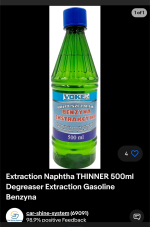MysticKestrel
Esteemed member
Hi all . This is my first post on the forum after say 8 months of using the how to guides when pointed in this direction by a friend.
I got given some un labelled naphtha to start of my extractions but now I've tried to purchase some myself.
I'm a bit worried about selecting the wrong stuff.
What solvent is best for extraction? I'm based in the U.K if that makes a difference to what is available. I have seen some vokes naphtha on eBay but not sure if that is safe or good enough?
Also is there any better solvents but naphtha that gives a cleaner extraction as I'm hoping to make juice for my sub ohm?
Thanks in advance,
Happy tripping !
I got given some un labelled naphtha to start of my extractions but now I've tried to purchase some myself.
I'm a bit worried about selecting the wrong stuff.
What solvent is best for extraction? I'm based in the U.K if that makes a difference to what is available. I have seen some vokes naphtha on eBay but not sure if that is safe or good enough?
Also is there any better solvents but naphtha that gives a cleaner extraction as I'm hoping to make juice for my sub ohm?
Thanks in advance,
Happy tripping !



 ... Should be fun
... Should be fun 
 ....
....